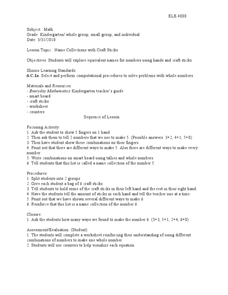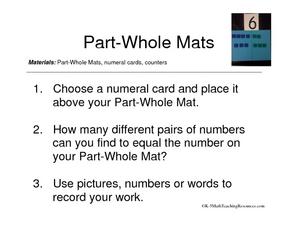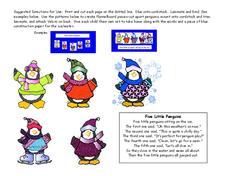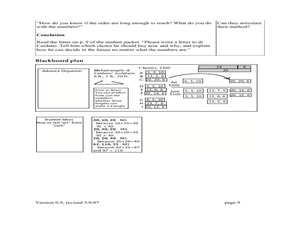Curated OER
New School Mural
Young muralists use digital images they take of buildings, locations, landmarks, or places inside the school to create an original work of art. After locating sites of importance and researching to find information, members try to...
Math Salamanders Ltd.
Multiplication as Repeated Addition to 10x10
The class works to change 15 repeated addition problems into their multiplication counterparts and then completes 15 more where they do the opposite. This is a great way to build an understanding of what multiplication is and could...
Math Salamanders Ltd.
Fraction Number Lines 1 to 2
Now that your elementary schoolers have completed number lines from zero to one give them this review sheet! Seven number lines are shown here, fractions included. Consider having your mathematicians add two or three new points on each...
Curated OER
Fractions and Paper Folding
In this fraction instructional activity, students manipulate paper by folding it to create different shapes and sizes, they explore the concept of fractions, and discuss their observations as a class. This is a great instructional...
Curated OER
Telling Time With Clocks/Bingo “Time”
Young learners create a clock by adding hands and placing the numbers in the correct location. After each learner has their very own clock, they explore each component. Review on the hour times, and then introduce them to five-minute...
Curated OER
Prime and Composite Number Mini Lab
Elementary schoolers determine the attributes of prime and composite numbers. Pupils, working in pairs, participate in an activity in which they use manipulatives to show the rectangles that can be made from square tiles. They practice...
Curated OER
Tides at the Battery, NY
Skill in using Excel and increasing proficiency in manipulating data are challenged with this data analysis work. A web link supplies data and step-by-step instructions help learners create a graph. There are many extension...
Curated OER
Which Fraction is Bigger or Smaller?
Compare fractions with common numerators! Pupils look at fractions with different denominators and the same numerator to find which one is bigger. They look at hands-on manipulations of fractions to understand the concept of why one is...
Curated OER
Name Collections with Craft Sticks
Groups of Kindergarten students count craft sticks in different groups and name how many they have. They complete simple addition to ten with the use of manipulatives.
Curated OER
Associative Property of Addition Worksheet
Here is a set of 16 problems in which the associative property of addition must be employed to solve. Tip: Provide concrete objects or manipulatives to aid struggling learners in understanding the concept.
Curated OER
Reproductive Biotechnology
Your agriculture students will learn some of the techniques involved in the reroductive health of animals and manipulation of embryos. The details included here are somewhat sensitive and also very specific techniques for general students.
Curated OER
Teaching Biology Through Bioinformatics
Learn more about the processes assisted by Bioinformatic Tools. Your class will learn how to research primary biological databases and the complex data that can be analyzed and manipulated to provide information. This information...
Curated OER
Linear Equations
This is a great instructional activity from start to finish. With partners and on their own, learners write and solve linear equations and inequalities. They use manipulatives, group work, and an included worksheet to make magic with...
Curated OER
Introduction to Scientific Investigation
What is a scientific investigation? What are the various parts of an experiment? This worksheet provides a basic review of most key terms: scientific method, manipulated variable, responding variable, hypothesis, controlled variable,...
Curated OER
Electronics and Alarms
Various situations are listed here and the state of conditions listed. The effect of those conditions on resistance in electronic circuits is explained and then pupils are told whether the transistor is switched on or off. These details...
Curated OER
Boyle's Law
After viewing this PowerPoint, physical science learners will be able to apply Boyle's law. Background information, reasoning, and data will help in understanding the behavior of gases. There are a few slides that require pupils to...
Curated OER
Multiplying and Dividing Decimals by 10. 100, and 1,000
Multiplying decimals by 10s, 100s, and 1,000s is easy once a student knows how to manipulate the decimal point. This short presentation covers this exact topic and does a good job of helping to show learners how easy it is to manage the...
Curated OER
Word Roots
Learners attempt puzzles using different Latin roots. This is an interactive, online tool, but you could use the same idea in your classroom by writing each letter on an index card and having pupils manipulate the cards until they are in...
Curated OER
Part-Whole Mats
A part-whole mat is a great way to practice simple addition using math manipulatives. Learners choose a number card and place it at the top of their mat. Using counters, they record the different number pairs which would add together to...
Orange County Public Schools
Five Little Penguins
Create adorable penguin-themed books and manipulatives with this cool resource. Instructions for use are provided, as are the stars of the show: five warmly dressed penguins who decide to go for a dip.
Curated OER
Adding and Subtracting Integers
Middle schoolers use discs in order to add and subtract integers. There are manipulatives present so kinesthetic learners can access the curriculum. They also review the concept of the opposite of positive and negative numbers.
Curated OER
Base Ten Blocks Rods and Flats (A)
Using visual cues and hands on manipulatives are great for conveying concepts in a concrete way. Learners are given a set of rods, they break the set up into flats, then count the rods left over to determine an answer. There are 5...
Curated OER
Art or Junk? Discovering the Triangle Inequality
Middle schoolers study the triangle inequality. They will identify, compare, and analyze attributes of two and three-dimensional shapes. Then they develop vocabulary to describe the attributes. They also use manipulatives to analyze the...
Pennsylvania Department of Education
Shapes Around Us
Learners use manipulatives to study shapes. They sort shapes and use correct geometric terminology to describe them. Students find real-life examples of 2 and 3 dimensional shapes, and classify figures in their classroom according to...
Other popular searches
- Math Manipulatives
- Fraction Manipulatives
- Addition Using Manipulatives
- Fractions With Manipulatives
- Geometry Manipulatives
- Division Manipulatives
- Manipulatives Adding Doubles
- Manipulatives Math Lessons
- Mixed Number Manipulatives
- Manipulatives Lesson Plans
- Manipulatives Place Values
- Edible Manipulatives























